The installation of spotlights is suitable for creating basic lighting and additional spot lighting. Due to the variety of cartridge designs, bulbs with different types of base can be used for mounting. The design of the devices is quite simple, so even a beginner in electrical work can figure out how to connect spotlights and correctly connect them to a home network.
- Device design and varieties
- Installation materials
- Installation requirements
- Connection diagrams for 220 V
- Serial connection
- Parallel wiring diagrams
- Connecting 12V spotlights
- Selecting the power of the converter / transformer
- Installation features
- In stretch ceilings
- In plasterboard ceilings
- Installation steps
- Location of spotlights
- Wire laying
- Hole preparation
- Connecting spotlights
- Anchoring
Device design and varieties
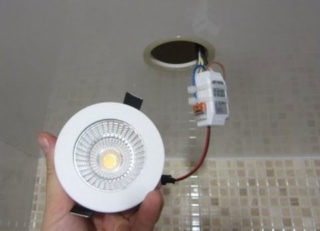
Most often, the connection of spotlights is performed in a hinged or overhead ceiling structure containing some space between the rough and finish surfaces. In these voids, the backs of the devices are located, as well as wiring and other elements responsible for the power supply. It is undesirable to place such lamps in the bathroom and other rooms with high humidity. One or more fixtures can be installed in a cabinet to create lighting.
Each individual luminaire includes the following elements:
- Reflective device with the ability to set the direction of the flow of light.
- Lamp. Bulbs of different types are used - with halogen gas, LED, fluorescent.
- Body with fasteners (spring mechanism and feet).
- Outer panel enclosing the area. It can have a variety of designs, colors, shapes (star, flower, etc.), be made of various materials - wood, plastic, metal.
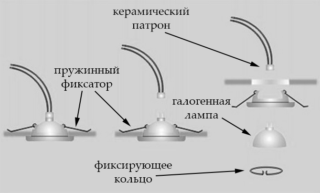
Luminaires can be divided into two categories according to the method of installation. The first ones are usually built into pre-arranged recesses, the second ones are mounted on the surface itself by means of special clamps. The last option is large in size; it will not work for a small room.
The type of lamps used also affects the performance of the device. Halogen options are distinguished by a long service life, brightness and natural lighting, environmental safety. But they also have disadvantages: high energy consumption and insufficient resistance to power surges. Devices with LEDs and fluorescent lamps are much more economical. When using the latter, you need to handle the flask very carefully, since there is a certain amount of mercury compounds in it. You need to be no less careful with halogens: you should not touch their flasks with your hands at all.
LED bulbs have the highest price of all types. But they serve for a long time and tolerate voltage surges up to 60 V. On sale you can find bulbs with white light and warm yellowish ones.
Installation materials
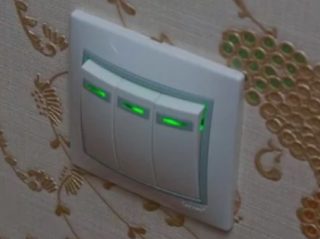
Before starting to equip niches and then connecting the lamps to the network, the master needs to make sure that the necessary materials and tools are available. You will need to buy:
- cables,
- light switch,
- insulating tape with heat shrink properties,
- clamping blocks and sleeves for wiring.
The required number of luminaires and lamps for them must be prepared.
The most important criteria for choosing a wire is fire resistance and resistance to high-temperature environments. RKGM copper wire, equipped with a double insulating coating, is well suited: the upper layer is made of fiberglass material, the lower one is made of rubber. Due to its heat resistance and incombustibility, such a cable can be installed even in a bath room.
Installation requirements
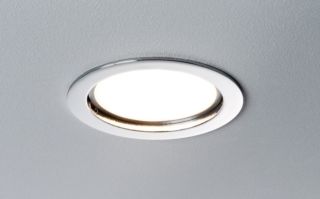
When intending to install a spotlight system, great importance must be attached to compliance with fire safety requirements. This is due to the peculiarities of the ceiling structures, where the devices are most often connected: often these are hinged systems, the elements of which are made of materials with flammability properties - PVC, plastic panels, sheet panels containing MDF.
Reliability of wiring and connection of cables, temperature of heating of lamps are of great importance. The latter is determined by their type: to achieve the same degree of illumination, the LED element must have a lower power than the halogen. If halogen elements or traditional tungsten filament bulbs were chosen, you need to be especially careful in choosing the type of wire, avoiding flammable options.
To reduce the heating of the space around the cables, it is recommended to install reflective elements and thermal rings.
Failure to follow fire safety rules can damage the insulation layer of the wires and cause short circuits.
Connection diagrams for 220 V
There are point devices with an operating voltage of 12 and 220 V. To operate devices of the first type, you will need to purchase a step-down transformer. From the point of view of safety, these devices are somewhat more advantageous, but designed for 220 V are easier to connect. There are several options for connecting them to your home power grid.
Serial connection
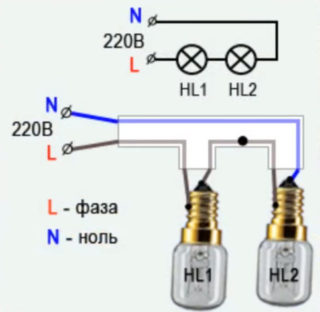
The daisy chain diagram of the luminaires is very simple and is implemented even by a master with minimal experience. However, during its implementation, there is a possibility of interruptions in the operation of the system, and if one lighting device fails, the circuit will break and the remaining lamps will also stop working. The connection of the spots to the electrical wiring is realized here sequentially one after the other. It is recommended to make the chain small, no more than 5-6 elements.
To restore the operation of the chain, you will need to disassemble it and test the operation of all spots in turn. The phase from one device is fed to the next, and zero is connected to the last. The pre-phase wire is directed to the switch. To install a triple wire structure, ground is applied to the corresponding terminals of each element. It can be organized through a light switch or a power socket.
Parallel wiring diagrams
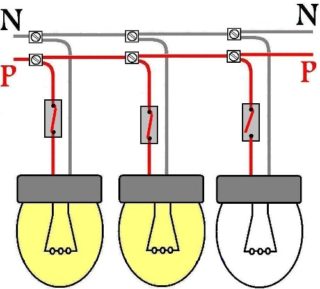
This version of the connection diagram for ceiling lamps is more difficult to implement. At the same time, the more spots are connected, the more time and financial resources will be spent. But this method ensures the operation of devices with the strength declared by the manufacturer, moreover, if one of them loses its performance, the rest of the lamps will continue to work. Due to this, this method does not lose its popularity.
When daisy chain from the junction box, the wire is pulled to the first device. A fragment of the second cable is connected to the output of the luminaire at one end and to the next element at the other. Such operations are repeated for each element. All devices will work from one switch. If it is decided to make zoning and divide the lamps into two blocks, you need to connect through a switch with two buttons.
When beam connection each device requires its own cable, so the circuit is the most difficult to implement. From the junction box, the wire is pulled to the center of the room, fixed it and a separate piece is pulled to each device.
Connecting 12V spotlights
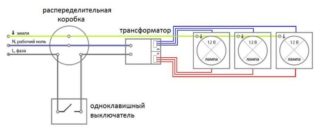
The wiring diagrams are identical in appearance, but the wire from the switch leads to the converter, and from its output clamps to the light bulbs. When using a large number of lighting fixtures, a two-button switch and a pair of transformers are used. Then the circuit has a form branched into two lines. For smooth regulation of the degree of illumination, it is recommended to use a dimmer switch with a button or a round handle.
Selecting the power of the converter / transformer
For the uninterrupted operation of the luminaires, it is required that the power of the device is 12-20% higher than the total indicator of the devices connected to it. If you need to purchase a step-down transformer device in order to connect 6 point lighting elements with 40-watt incandescent bulbs to it, the optimal power indicator for it will be (6 * 40) * 1.2 = 288 W (in practice - 280).
To connect a large number of light sources, high-power transformers with large dimensions are required. It is often difficult to find the optimal place to place such a device in a room. You can divide the sources into two groups and connect a device of a suitable power to each.
Installation features
The sequence and set of operations for different types of ceiling structures will be slightly different.
In stretch ceilings
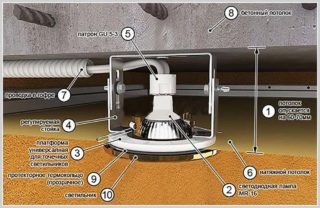
The cabling is pre-assembled, fixed to the ceiling, but not connected to the power supply. Install pendant lighting devices. Then they connect cables to them and check the correct functioning. Before arranging the tension structure, turn off the power, dismantle light bulbs and components that can suffer from a high-temperature environment. At the end of the work, holes are cut in the ceiling, sealing rings are installed and the devices are assembled.
In plasterboard ceilings
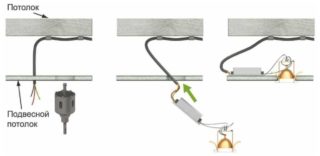
It is advisable to mark the position of future lamps on the surface and then prepare niches using a drill equipped with a crown of a suitable size. When cutting the wire, you can leave a spare length of up to 20 cm, correcting for position offsets. Keep in mind, however, that the cables are attached to the base ceiling surface. They should stick out 6-10 cm above the drywall, and it is easier to cut off the excess length than adding the missing one.
Installation steps
A proper work sequence must be followed to obtain a reliable design.
Location of spotlights
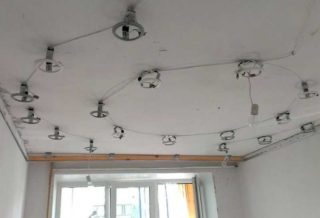
At this stage, a sketch is prepared indicating the points of placing the spots and the distances between them. The distance from the device to the wall should be at least 0.6 m, to another lamp - 1 m or more.
Wire laying
It is better to do this before installing the stretch cover. After installing the frame on which it is planned to attach the sheets, the phase and neutral conductors are placed, focusing on the selected scheme and the location of the spots. Commutation is carried out using sleeves and a crimping press.
Hole preparation
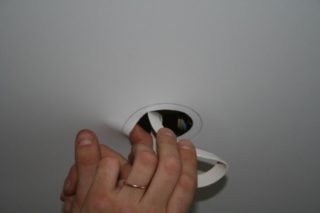
Use a drill and bit to match the ceiling material and hole size. In the absence of a crown, the boundaries of the holes are marked with a pencil and cut with a clerical knife.
Connecting spotlights
It is produced with a de-energized network. It is easiest if the fixtures are wired by default. Otherwise, loosen the terminal clamps, twist the ends with your hands and press down with pliers.
Anchoring
Typically, the spots are fastened with a pair of side brackets, which are folded up to the stop and placed in the ceiling opening.They must not come into contact with power cables.
The main wire is connected to the switch and the junction box. Turning on the power, check the performance of the lamps.








